Leskovac
Leskovac (Serbian Cyrillic: Лесковац, pronounced [lě̞skɔ̝v̞at͡s]) is a city and the administrative center of the Jablanica District in southern Serbia. According to the 2011 census, the city urban area has 60,288 inhabitants, while the city administrative area has 144,206.
Leskovac Град Лесковац | |
|---|---|
| City of Leskovac | |
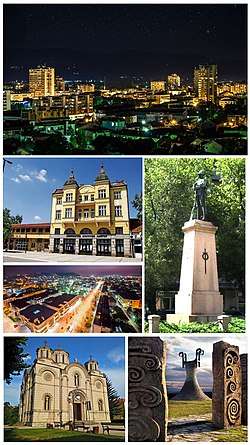 From top: City Hall, Kaloderma Palace, Odžaklija church, National Theatre, Serbian Orthodox church, Memorial Park of the Revolution | |
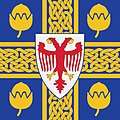 Flag 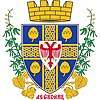 Coat of arms | |
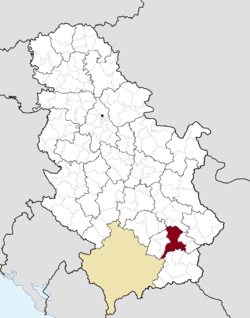 Location of the city of Leskovac within Serbia | |
| Coordinates: 43°00′N 21°57′E | |
| Country | |
| Region | Southern and Eastern Serbia |
| District | Jablanica |
| Settlements | 144 |
| Government | |
| • Mayor | Goran Cvetanović (SNS) |
| Area | |
| Area rank | 5th in Serbia |
| • Urban | 25.27 km2 (9.76 sq mi) |
| • Administrative | 1,025 km2 (396 sq mi) |
| Elevation | 228 m (748 ft) |
| Population (2011 census)[2] | |
| • Rank | 12th in Serbia |
| • Urban | 60,288 |
| • Urban density | 2,400/km2 (6,200/sq mi) |
| • Administrative | 144,206 |
| • Administrative density | 140/km2 (360/sq mi) |
| Time zone | UTC+1 (CET) |
| • Summer (DST) | UTC+2 (CEST) |
| Postal code | 16000 |
| Area code | +381(0)16 |
| Car plates | LE |
| Website | www |
History
Prehistory
Traces of life of the Brnjica culture (8th century BC) is seen at the Hisar Hill (Hisar Leskovac) that was protected by a deep moat with a palisade on its inner side, a fortification similar to that of another fortification on the Gradac site near Zlokućane in the Velika Morava basin.[3][4] A later Iron Age settlement existed at Hisar dating from the 6th century BC until the 4th century BC.[4] Besides Greek fibula and pottery, Triballi (Thracian) tombs have been excavated in 2005.[5]
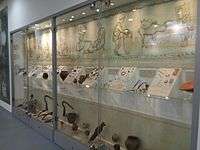
Archeological findings from the multi-layer sites indicate that the Scordisci and Triballi inhabited the Leskovac valley before the Roman conquest in the 1st century BC.[4] Famous cultural-historic monuments in this area are: the Roman necropolis in Mala Kopasnica originating from 2nd century AD, the Eastern Roman town of Justiniana Prima built in 535 AD.
Middle Ages
Slavs settled the Balkans in the 6th and 7th centuries. The province was known as Dendra in Greek, and Glubočica (Глубочица, later Dubočica) in Slavic. Dendra was given to Serbian ruler Desa in 1155.[6][7][8] It was then held by Grand Prince Stefan Nemanja.[6]
The Battle of Dubočica took place on September 24, 1454, between the Serbian Despotate and the invading Ottoman Empire, and ended in a Serbian victory. During Ottoman rule Leskovac was part of the Sanjak of Niš.[9] The Jasunje monasteries dedicated to the Virgin of Transfiguration and St. John the Baptist were built in 1499 as an endowment of sister Ksenija.
Early modern
The Church of St. John the Baptist was built in the 16th century.
Before 1877 Leskovac had a total population of 46,500, of which 22,500 were Serbs and 24,000 Albanians.[10] The urban Muslim population of Leskovac consisted of Albanians and Turks of whom a part were of Albanian origin.[11] During the Serbian–Ottoman War (1876–1878) the Muslim population of Leskovac fled to the Ottoman vilayet of Kosovo and resettled in cities of Macedonia and Kosovo, in particular Pristina were they dominated trade.[11]
Modern
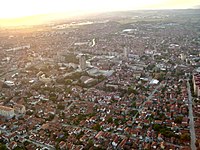
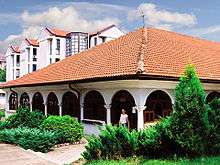
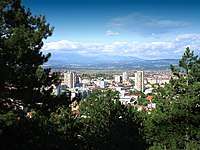
Leskovac became part of Serbia after the Treaty of Berlin in 1878, at which time Serbia also became fully independent from the Ottoman Empire. Full independence from the Ottoman Balkans initially had a negative impact on trade. However, by the end of the 19th century, the town of Leskovac was famous across the Balkans for its workshops which turned hemp into rope. Leskovac was known as Leskofça during Ottoman rule and was bounded to Niş sanjak until 1878.
Soon there were three watermill-driven lace producers in the region. In 1896, the founders of these companies pooled their resources and bought factory equipment for the production of woollen cloth from the German Empire. This was the first factory on the outskirts of the town. In 1903, a factory for hemp processing was built on the riverbank north of the old town centre. Amidst the First Serbian Uprising of the Serbian revolution (1804–1815), a forbidden Serbian Orthodox church was built in the town, through tricking the Turkish lords that the building would instead serve as a residence for the town-priest, and added a chimney, hence its name Odžaklija (Chimney). In 1922, the Teokarević family opened a wool cloth factory in the small town of Vučje near Leskovac. By 1938, the private textile factories of Leskovac town employed 2,560 workers. In the 1870s, there were thousands of hemp-processors in Leskovac, producing up to 150,000 cartloads per year. The city was once known as "Little Manchester", because of its 19th-century textile industry which was second only to that of Manchester, England. The city continued to be a major textile center until the collapse of communism in Eastern Europe, but due to the economic isolation of Serbia resulting from ethnic wars, its remote location, and failure to privatize the mills, the industry collapsed resulting in depression of the economy in the area.[12]
From 1929 to 1941, Leskovac was part of the Vardar Banovina of the Kingdom of Yugoslavia.
World War II
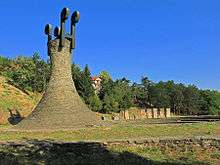
During the World War II, the city was part of German-occupied Serbia. It was heavily bombed by the Allies in 1944, with estimates of civilian casualties varying from over a thousand to six thousand.[13][14] The heaviest bombing occurred on September 6, 1944 when most of the central part of the town was destroyed.[15] The date is marked annually in the city.
Fitzroy Maclean the head of the British military mission to the Partisans wrote ..... as we watched the whole of Leskovac seemed to rise bodily in the air in a tornado of dust and smoke and debris, and a great rending noise fell on our ears. ..... What was left of Leskovac lay enveloped in a pall of smoke; several buildings seemed to be burning fiercely. Even the Partisans seemed subdued. This was part of Operation Ratweek to attack the enemy withdrawal, and air reconnaissance had confirmed the presence of a strong concentration of armour and motor transport there, although he said the use of 50 ‘Heavies’ or Flying Fortresses did seem rather like taking a sledge-hammer to crack a walnut..[16]
Kosovo conflict
On 12 April 1999, during the NATO bombing of Yugoslavia a bridge near Leskovac (Grdelička klisura) was destroyed by a NATO aircraft as a passenger train was crossing. The act was highly condemned with the bridge being struck twice (the train itself having been bombed from the first attack).
Geography
Leskovac is situated in the heart of the vast and fertile valley of Leskovac (50 km (31 mi) long and 45 km (28 mi) wide), the small Veternica river, at the foot of Hisar, in the central part of the Leskovac valley. Leskovac lies at an altitude of 228 meters, in a basin that covers 2,250 km2 (869 sq mi). Around the valley are mountains Radan and Pasjača the west, Kukavica and Čemernik in the south and Babička Gora, Seličevica and Suva Planina to the east.
Climate
| Climate data for Leskovac (1981–2010) | |||||||||||||
|---|---|---|---|---|---|---|---|---|---|---|---|---|---|
| Month | Jan | Feb | Mar | Apr | May | Jun | Jul | Aug | Sep | Oct | Nov | Dec | Year |
| Record high °C (°F) | 20.0 (68.0) |
25.0 (77.0) |
27.8 (82.0) |
32.6 (90.7) |
34.5 (94.1) |
38.6 (101.5) |
43.7 (110.7) |
41.3 (106.3) |
36.8 (98.2) |
32.4 (90.3) |
28.6 (83.5) |
21.4 (70.5) |
43.7 (110.7) |
| Average high °C (°F) | 4.4 (39.9) |
7.1 (44.8) |
12.7 (54.9) |
18.0 (64.4) |
23.2 (73.8) |
26.5 (79.7) |
29.1 (84.4) |
29.4 (84.9) |
24.5 (76.1) |
18.8 (65.8) |
11.3 (52.3) |
5.6 (42.1) |
17.6 (63.7) |
| Daily mean °C (°F) | 0.0 (32.0) |
1.7 (35.1) |
6.4 (43.5) |
11.4 (52.5) |
16.4 (61.5) |
19.7 (67.5) |
21.6 (70.9) |
21.2 (70.2) |
16.3 (61.3) |
11.2 (52.2) |
5.5 (41.9) |
1.4 (34.5) |
11.1 (52.0) |
| Average low °C (°F) | −3.7 (25.3) |
−2.7 (27.1) |
1.1 (34.0) |
5.2 (41.4) |
9.7 (49.5) |
13.0 (55.4) |
14.3 (57.7) |
13.9 (57.0) |
10.1 (50.2) |
5.9 (42.6) |
1.2 (34.2) |
−2.0 (28.4) |
5.5 (41.9) |
| Record low °C (°F) | −30.5 (−22.9) |
−26.8 (−16.2) |
−18.2 (−0.8) |
−6.1 (21.0) |
−1.7 (28.9) |
2.7 (36.9) |
5.4 (41.7) |
4.4 (39.9) |
−3.8 (25.2) |
−8.7 (16.3) |
−19.6 (−3.3) |
−21.7 (−7.1) |
−30.5 (−22.9) |
| Average precipitation mm (inches) | 42.2 (1.66) |
45.7 (1.80) |
45.9 (1.81) |
60.5 (2.38) |
55.8 (2.20) |
64.1 (2.52) |
44.2 (1.74) |
47.3 (1.86) |
51.4 (2.02) |
51.1 (2.01) |
61.9 (2.44) |
55.2 (2.17) |
625.4 (24.62) |
| Average precipitation days (≥ 0.1 mm) | 13 | 13 | 12 | 13 | 13 | 11 | 8 | 7 | 9 | 10 | 12 | 14 | 137 |
| Average snowy days | 9 | 8 | 5 | 1 | 0 | 0 | 0 | 0 | 0 | 0 | 3 | 8 | 35 |
| Average relative humidity (%) | 82 | 77 | 70 | 68 | 69 | 68 | 65 | 66 | 73 | 77 | 81 | 83 | 73 |
| Mean monthly sunshine hours | 66.6 | 90.1 | 145.6 | 168.0 | 224.3 | 255.3 | 296.8 | 288.6 | 207.4 | 147.3 | 85.4 | 50.9 | 2,026.1 |
| Source: Republic Hydrometeorological Service of Serbia[17] | |||||||||||||
Rivers
The largest river in the region of Leskovac is the South Morava River, which flows south to north. Tributaries of the South Morava are: the Vlasina river, which collects water from Lake Vlasina and flows through Crna Trava and Vlasotince; the Veternica river, which flows through Leskovac; the Jablanica river, which springs from the foot of Goljak and flows through Medveđa and Lebane; the Pusta (Deserted) river, which starts on Radan mountain, fills Lake Brestovačko and flows through Bojnik. The river Vučjanka, which springs from the Kukavica mountain, flows through Vučje and is a tributary of the Veternica river. Also known in the Leskovac region are Kozaračka, Predejanska, Kopašnička and Sušica rivers.
Demographics
| Year | Pop. | ±% p.a. |
|---|---|---|
| 1948 | 113,158 | — |
| 1953 | 121,311 | +1.40% |
| 1961 | 134,250 | +1.27% |
| 1971 | 147,487 | +0.94% |
| 1981 | 159,001 | +0.75% |
| 1991 | 161,986 | +0.19% |
| 2002 | 156,252 | −0.33% |
| 2011 | 144,206 | −0.89% |
| Source: [18] | ||
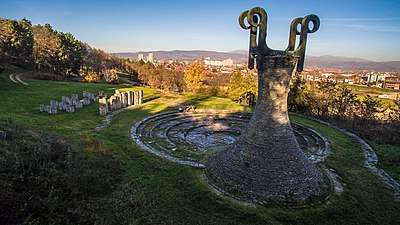
According to the 2011 census results, there are 144,206 inhabitants in the city of Leskovac.
Ethnic groups
In 2011 the city's population was 95,784 of whom majority are Serbs. Other significant ethnic groups include Roma, Macedonians and Yugoslavs. In January 2007, there were an estimated 500 persons of Chinese origin living in Leskovac.[19] Apart from the city proper, there are 143 populated places in the city, of which the largest are Vučje and Grdelica, classified as "urban" (town) in census, with about 3000 residents each.[2]
The ethnic composition of the city administrative area:[20]
| Ethnic group | Population | % |
|---|---|---|
| Serbs | 133,623 | 92.66% |
| Roma | 7,700 | 5.34% |
| Macedonians | 291 | 0.20% |
| Montenegrins | 192 | 0.13% |
| Bulgarians | 91 | 0.06% |
| Yugoslavs | 88 | 0.06% |
| Croats | 55 | 0.04% |
| Albanians | 20 | 0.01% |
| Slovenians | 19 | 0.01% |
| Muslims | 19 | 0.01% |
| Germans | 19 | 0.01% |
| Hungarians | 15 | 0.01% |
| Russians | 13 | 0.01% |
| Others | 2,061 | 1.43% |
| Total | 144,206 |
At one time the second largest city in Serbia, today Leskovac is blighted by economic problems with many working age people migrating out of the area.[12]
Subdivisions

There are 144 villages located within the municipality:
Culture
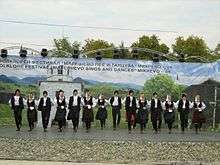
Events
Roštiljijada

Roštiljijada (Barbecue week) is a grilled meat festival that has been organized in Leskovac for many years and takes place annually at the beginning of September. During the event, the main boulevard is closed for traffic for five days, and food stands are put up along the streets. The event brings visitors from all over Serbia as well as tourists. According to the TOL (Tourism Organization of Leskovac) in 2013, over 700,000 people visited the event.[21] The organisers hold competitions, such as making the biggest burger, the Pljeskavica. The festival is the highlight of the season in Leskovac.
International Carnival
In 2009 Leskovac officially became an International Carnival city, admitted by The Association of European Carnival cities, which has over 50 members from Europe and America. The Leskovac Carnival is held at a time of Roštiljijada festival. Around 1200 people take part in the carnival, of which one-third part from abroad. The City Government considered separating this event in 2010. as a special tourist event which will be introduced as a special offer of the city.
Theater Marathon
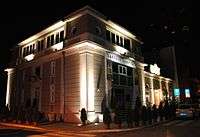
Theater Marathon takes place every year in November and lasts 9 days. It runs performances of National Theaters from all over Serbia. This event takes place in the National Theater in Leskovac.
Leskovac International Film Festival
The first Leskovac International film festival was held in 2008. The idea of the film in the city is not that new. In 1996, a group of enthusiasts, with chairman Rade Jovic, organized the Festival which were shown films of domestic production. Today, many years later, Leskovac host an International Film Festival. The Festival presents awards in 3 categories:
- "Golden hazelnuts" - Best Director
- "Hazelnut leaf" - critics awards
- "Vox populi" - Audience Award.
Cultural heritage
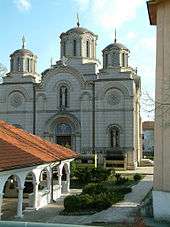
- Monastery of John the Baptist, Leskovac
- Monastery of the Presentation of the Holy Mother of God, Leskovac
- Rudare Monastery
- Čukljenik Monastery
- Leskovac Cathedral
- Odžaklija Church
- Memorial Park to the Revolution (1971) by famed Yugoslav architect Bogdan Bogdanović
Sports
Leskovac has a proud sporting history and is home to several teams, including football club's GFK Dubočica, FK Sloga Leskovac, basketball team KK Zdravlje, and handball team RK Dubočica 54.
Economy and infrastructure
Economy of Leskovac is diverse, but it is still somewhat stagnating as a city in whole. Overall, industry has a minor growth, but its growth is safe and in the future, industry will certainly face another growth that will increase its status among Serbia's largest cities. Its main industry is light industry such as textile, household commodities and medical industries. Leskovac has mine of lead and zinc called "Leskovac Lece".
The first boom occurred after WW1 and lasted until 1941. It was "succeeded" in the late 1940s. During so called "Yugoslav economic miracle" (1950s – c.1980) Leskovac has developed into not just regional, but textile center in entire Southeast Europe. It became known as "Serbian Manchester". Leskovac Lece was constructed during that era. During the NATO bombing of Yugoslavia, Leskovac was severely damaged like no other city in Europe at the time.
The following table gives a preview of total number of registered people employed in legal entities per their core activity (as of 2018):[22]
| Activity | Total |
|---|---|
| Agriculture, forestry and fishing | 249 |
| Mining and quarrying | 18 |
| Manufacturing | 10,709 |
| Electricity, gas, steam and air conditioning supply | 306 |
| Water supply; sewerage, waste management and remediation activities | 627 |
| Construction | 1,142 |
| Wholesale and retail trade, repair of motor vehicles and motorcycles | 5,002 |
| Transportation and storage | 1,211 |
| Accommodation and food services | 1,007 |
| Information and communication | 311 |
| Financial and insurance activities | 339 |
| Real estate activities | 139 |
| Professional, scientific and technical activities | 896 |
| Administrative and support service activities | 466 |
| Public administration and defense; compulsory social security | 1,513 |
| Education | 2,402 |
| Human health and social work activities | 2,671 |
| Arts, entertainment and recreation | 403 |
| Other service activities | 544 |
| Individual agricultural workers | 1,459 |
| Total | 31,415 |
Transportation
Leskovac is a traffic junction. International trains traveling from Europe to Skopje, Thessalonica and Athens pass through this city. Nineteen trains stop in Leskovac every day. The railway came to Leskovac in 1886. Leskovac today has one of the newest and most modern railway stations in Serbia.
Bus traffic is also very well developed, bearing in mind that Leskovac has been criss-crossed with roads. The most important is the E75 road which connects the borders of Hungary and North Macedonia. Regional roads lead from Leskovac to Priština, Pirot and Bosilegrad. The distance from Leskovac to Niš is 45, to Belgrade 280, and to Sofia 155 kilometres (96 miles).
Leskovac has a regional airport, which is commonly used for sporting and agricultural flights. Also in summer the airport is used for air taxi. The nearest international airport is Niš Constantine the Great Airport located 45 km (28 mi) north of the city.
Environment
Leskovac was the first city in Serbia which had a sanitary landfill. Željkovac depot spreads over 80 hectares and is made by all European standards. In the landfill there is a center for atmospheric water purification, center for the selection and disposal systems for the detection of all types of pollution. Company Por Werner and Weber for Serbia, began construction of the center for collecting and recycling waste, and is the first city in the Balkans, where starting this job.
Notable people
- Vladimir Milošević, concert pianist
- Zvonko Marić, member of SANU
- Nikola Skobaljić, medieval nobleman and military commander.
- Ilija Strelja, One of the Serbian lords and military leaders during Serbian revolution.
- Momir Stojanović Leader and one of the Serbian lords and titular lord of Leskovac at the end of Serbian revolution, took part in storming of Belgrade and single handedly cut down 70 Turks.
- Jovan Spasić, goalkeeper for Yugoslavia.
- Nikola Dekleva, doctor.
- Bojan Dimitrijević, actor.
- Nenad Filipović, athlete.
- Predrag Filipović, athlete.
- Mija Kulić, satirist and artist.
- Sloboda Mićalović, actress.
- Gojko Mitić, famous actor in Germany.
- Ahmed Ademović, Roma trumpeter who fought in the battle of Kumanovo, distinguished for his bravery in battle.
- Trajko Rajković, basketball player, Olympic silver medalist and World champion
- Jovica Arsić, professional basketball coach.
- Ljubiša Stojanović Louis, singer.
- Miodrag Stojković, geneticist.
- Goran Stojiljković, athlete.
- Nebojša Stefanović, ultramarathon.
- Bratislav Živković, footballer.
- Bojan Janić, volleyball player, World and European championships bronze medalist.
- Marko Perović, footballer.
- Predrag Stanković, footballer.
- Obrad Belošević, basketball referee.
- Maja Miljković, basketball player.
- Žak Konfino, physician and writer.
- Toma Zdravkovic, singer.
International relations
Twin towns — sister cities
Leskovac is twinned with:[23][24]

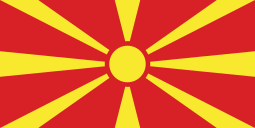



See also
- Leskovac Airport
References
- "Municipalities of Serbia, 2006". Statistical Office of Serbia. Retrieved 2010-11-28.
- "2011 Census of Population, Households and Dwellings in the Republic of Serbia: Comparative Overview of the Number of Population in 1948, 1953, 1961, 1971, 1981, 1991, 2002 and 2011, Data by settlements" (PDF). Statistical Office of Republic Of Serbia, Belgrade. 2014. p. 450. ISBN 978-86-6161-109-4. Retrieved 2014-06-27.
- Stojic 1986, 61–62. YU
- "Archived copy" (PDF). Archived from the original (PDF) on 2010-07-05. Retrieved 2010-07-05.CS1 maint: archived copy as title (link)
- "Praistorijska kopča : Leskovac -- Arheološki lokalitet brdo Hisar, iznad Leskovca, ne prestaje da iznenađuje istraživače". B92.net. Retrieved 29 December 2017.
- Dragoljub Trajković (1968). Glubočica u novijim istoriografskim i drugim podacima: kritički osvrti, prikazi i beleške (1946-1966). Narodni muzej. p. 10.
- Recueil de travaux de l'Institut des études byzantines. Naučno delo. 1996.
- Dragoljub M. Trajković (1961). Nemanjina Dubočica.
- Godišnjak grada Beograda. Museum of the Belgrade. 1977. p. 116. Retrieved 11 July 2011.
- "Debimi nga Sanxhaku i Nishit" (PDF). asha-ks (in Albanian). Retrieved 2020-02-09.
- Jagodić, Miloš (1998). "The Emigration of Muslims from the New Serbian Regions 1877/1878". Balkanologie. 2 (2).CS1 maint: ref=harv (link) para. 6. "According to the information about the language spoken among the Muslims in the cities, we can see of which nationality they were. So, the Muslim population of Niš and Pirot consisted mostly of Turks; in Vranje and Leskovac they were Turks and Albanians"; para. 11. "The Turks have been mostly city dwellers. It is certain, however, that part of them was of Albanian origin, because of the well-known fact that the Albanians have been very easily assimilated with Turks in the cities."; para. 30-31, 40, 47.
- "A Serbian Region Unravels With Its Textile Industry", article by Nicholas Wood in The New York Times, January 29, 2007
- "Nepotrebna i besmislena bombardovanja". Glas-javnosti.rs. Retrieved 29 December 2017.
- "Godišnjica savezničkog bombardovanja Leskovca". Kurir-info.rs. Archived from the original on 9 March 2012. Retrieved 29 December 2017.
- Maclean, Fitzroy (1949). Eastern Approaches (pp486-7). Jonathan Cape, London.
- "Monthly and annual means, maximum and minimum values of meteorological elements for the period 1981-2010" (in Serbian). Republic Hydrometeorological Service of Serbia. Retrieved May 21, 2020.
- "2011 Census of Population, Households and Dwellings in the Republic of Serbia" (PDF). stat.gov.rs. Statistical Office of the Republic of Serbia. Archived from the original (PDF) on 14 July 2014. Retrieved 11 January 2017.
- ESI, European Stability Initiative - (29 December 2017). "European Stability Initiative - ESI". Esiweb.org. Retrieved 29 December 2017.
- "2011 Census of Population, Households and Dwellings in the Republic of Serbia" (PDF). stat.gov.rs. Retrieved 1 February 2018.
- "Traductor de Google". translate.google.com.
- "MUNICIPALITIES AND REGIONS OF THE REPUBLIC OF SERBIA, 2019" (PDF). stat.gov.rs. Statistical Office of the Republic of Serbia. 25 December 2019. Retrieved 27 December 2019.
- "Menu О Лесковцу => Основно => Градови побратими". gradleskovac.rs (in Serbian). Leskovac. Retrieved 2020-01-07.
- "Лесковац (Србија)". gradbijeljina.org (in Serbian). Bijeljina. Retrieved 2020-01-07.
Further reading
- Stojančević, V. (1980) Leskovac za vreme Prvog srpskog ustanka. in: Stojančević V. [ed.] Leskovčani za vreme Prvog srpskog ustanka 1804–1813, Leskovac, 267-8
- Stojančević, V. (1980) Prvi srpski ustanak i leskovački kraj. in: Stojančević V. [ed.] Leskovčani za vreme Prvog srpskog ustanka 1804–1813, Leskovac, 67-8
External links
| Wikimedia Commons has media related to Leskovac. |
